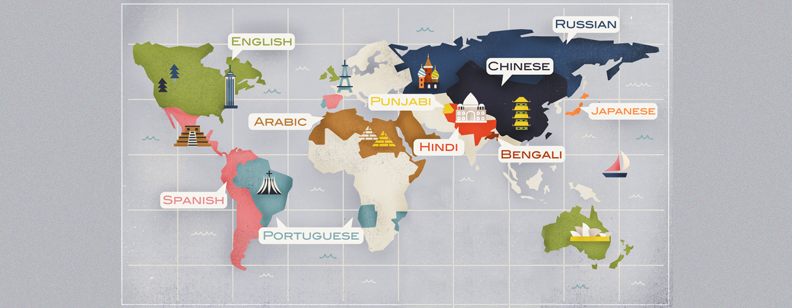Studies have revealed how information flows across different countries to communicate and spread ideas far and wide. It’s a fact; speak or write in English and the world will hear you. Choose to speak or write in Tamil or Portuguese, you may find it difficult and hard to get the message out. According to statistics the second best language is Spanish or Chinese.
The study of mapping out best speaking language incited by a conversation about an untranslated book. A master’s thesis formed the basis of this new research. A bilingual Hebrew-English speaker told his MIT adviser who was a Spanish-English speaker, about an untranslated book written in Hebrew whose translation into English he wasn’t yet aware of. He then initiated his research about how to create worldwide maps of information and ideas transmitting for multilingual people.
Researchers tackled the problem by describing three global language networks based on bilingual tweeters, book translations, and multilingual Wikipedia edits. The book translation network maps number of books translated into other languages. That network is based on 2.2 million translations of printed books published in more than 1000 languages. For tweets, the researchers used 550 million tweets by 17 million users in 73 languages. In that network, if a user tweets in, say, Hindi as well as in English, the two languages are connected. To build the Wikipedia network, the researchers tracked edits in up to five languages done by editors, carefully excluding bots.
It was observed that English has the most transmissions; to and from other languages and is the most central hub, in all three networks. On the other hand the maps also disclose “a halo of intermediate hubs,” such as French, German, and Russian, which serve the same function at a different scale.
In contrast, some languages with large populations of speakers, such as Mandarin, Hindi, and Arabic, are relatively quarantined in these networks. This concluded that fewer communications in those languages reach speakers of other languages. Meanwhile, a language like Dutch—spoken by 27 million people— was shown to be an unreasonably large channel, compared with a language like Arabic, which has a massive 530 million native and second-language speakers. This was accredited to Dutch which was very multilingual online.
The network maps only reveals what is already widely known: If you want to get your ideas out, you can reach a lot of people through the English language. However it also discloses how speakers in distinct languages benefit from being indirectly associated through hub languages large and small. On Twitter, for example, ideas in Filipino can supposedly move to the Korean-speaking sphere of influence through Malay, whereas the most likely path for ideas to go from Turkish to Malayalam (spoken in India by 35 million people) is through English.
The authors note that the users they studied, whom they consider literate since they are online, do not represent all the speakers of a language. However, these elites of global languages have a disproportionate amount of power and responsibility, because they are silently the perspectives in which distant cultures comprehend each other—even if this is not their goal,” Hidalgo says. Most people learned about the conflict in Ukraine 2014 through news stories initially written in English and then translated to other languages. In this case, “any unspoken bias or angle taken by the English media will color the material about the conflict available now to many non-English speakers.
The networks potentially offer guidance to governments and other language communities that want to change their international role. If a country wants its national language to be more prominent, then it should invest in translating more documents, boosting more people to tweet in their national language. On the contrary, if a country wants their ideas to spread, it should pick a second language that’s very well connected.
For those who don’t speak English, English as second or third language is a clear option for them. For English speakers, the analysis suggests it would be more beneficial to choose Spanish over Chinese especially if they’re spreading their ideas through writing.
The problem of measuring the relative status of the world’s languages “is a very tricky one, and often very hard to get good data about,” says Mark Davis, the president and co-founder of the Unicode Consortium in Mountain View, California, which does character encoding for the world’s computers and mobile devices. “Their perspective on the problem is interesting and useful.”
Cultural transmission happens in spoken language too. Data on interactions reveal the souks of Marrakech, where people speak Arabic, Hassaniya, Moroccan Arabic, French, Tashelhit, and other languages, are impossible to get but important in cultural transmission. As internet becomes available to more people around the world, they go online in their own languages. When they do so they know how to connect to other languages and move their ideas, too.



